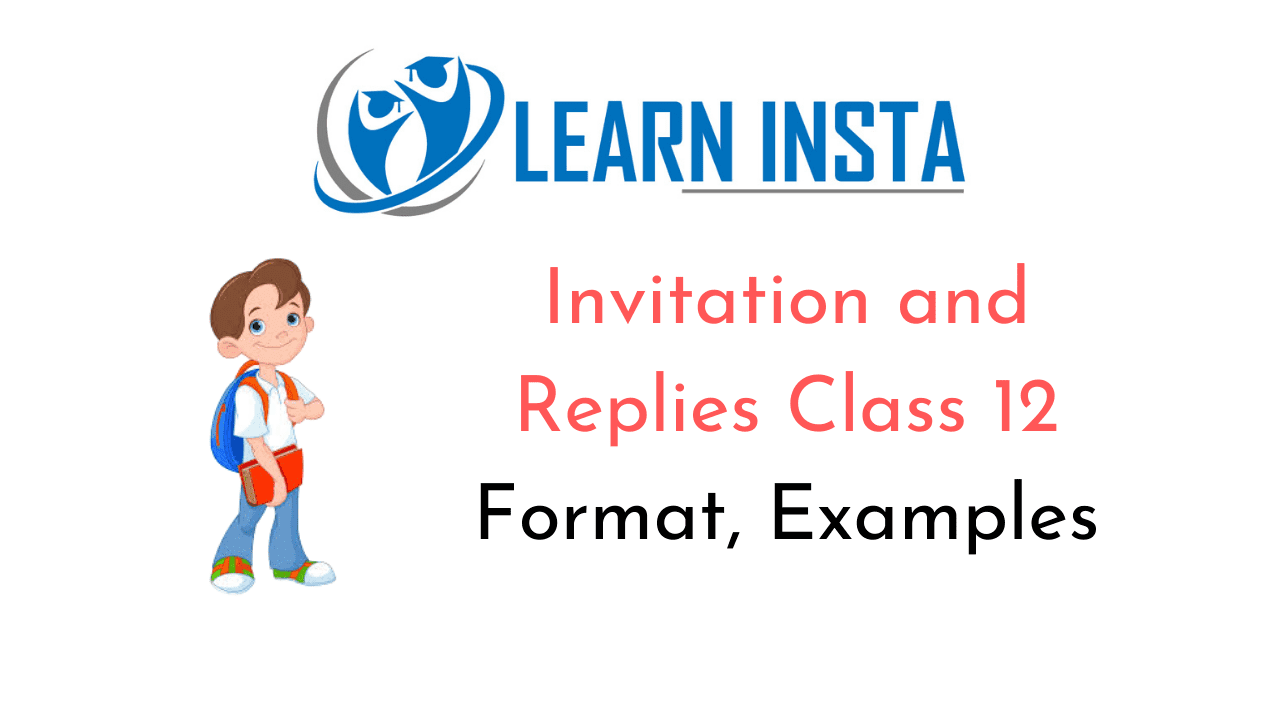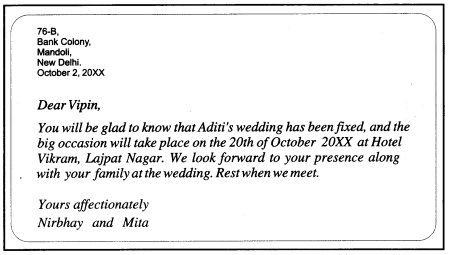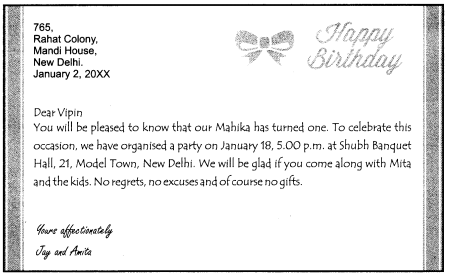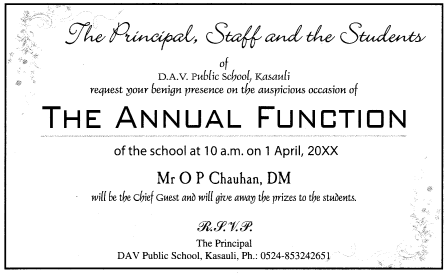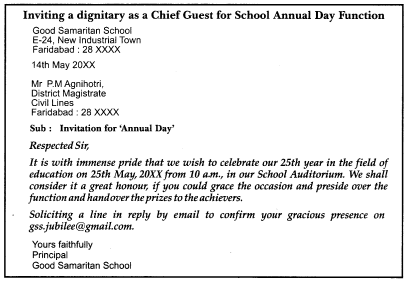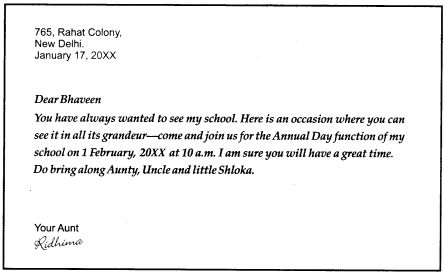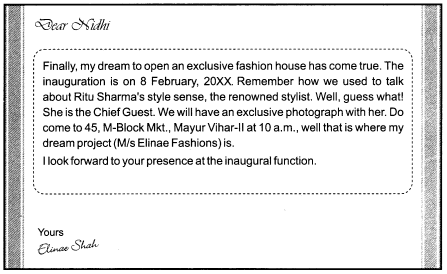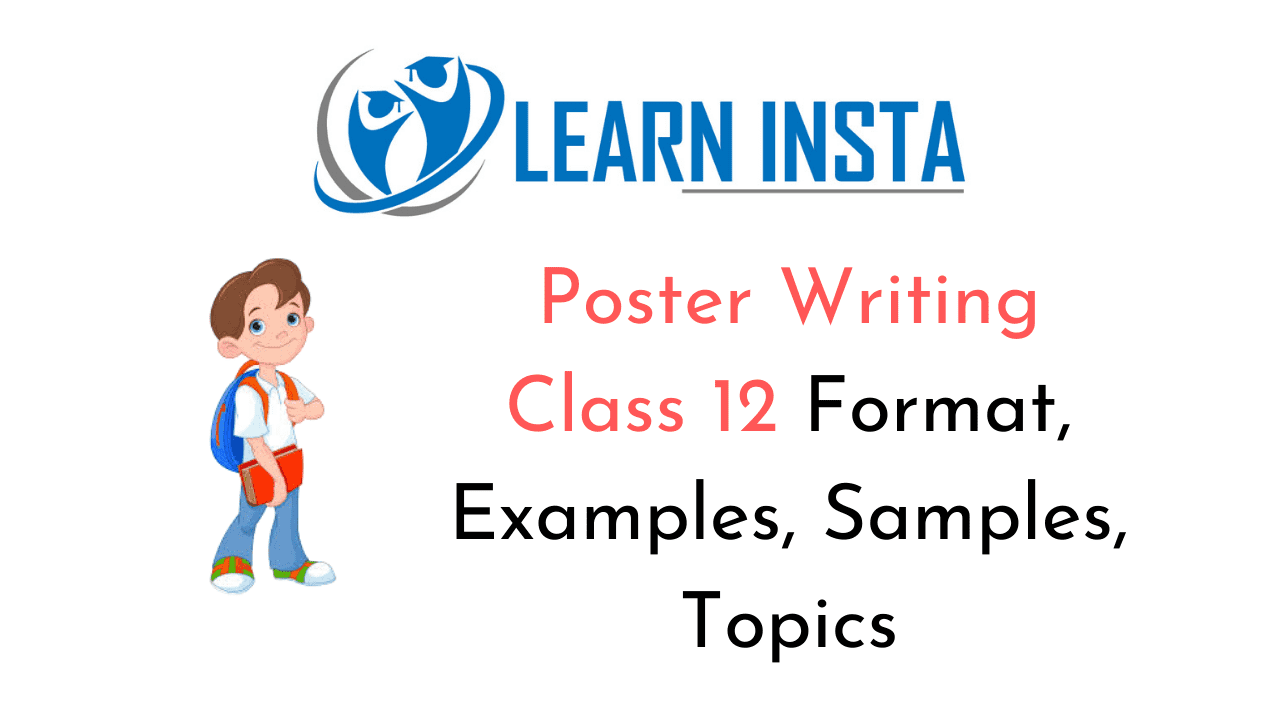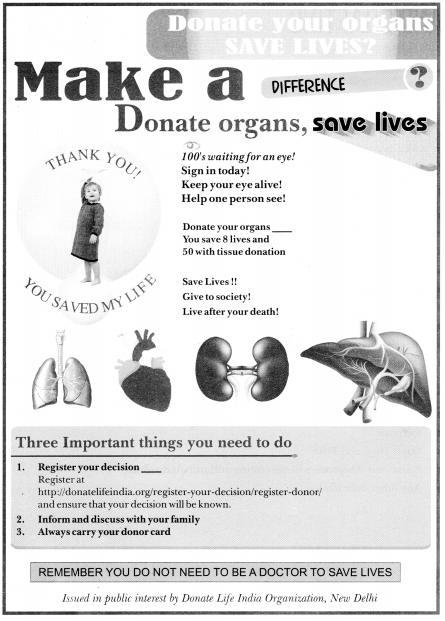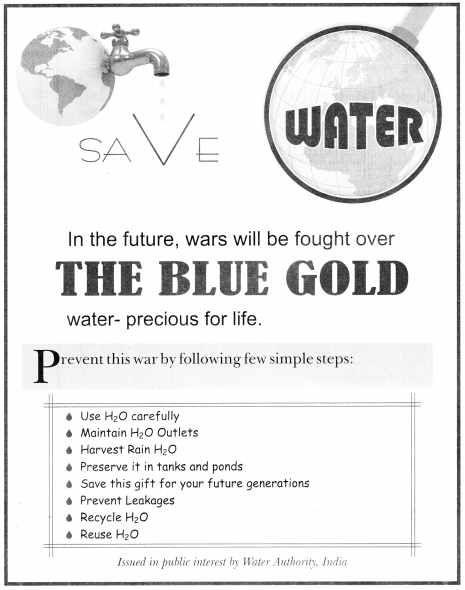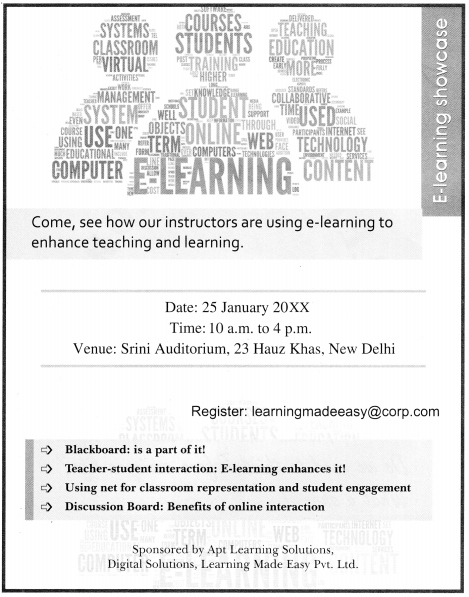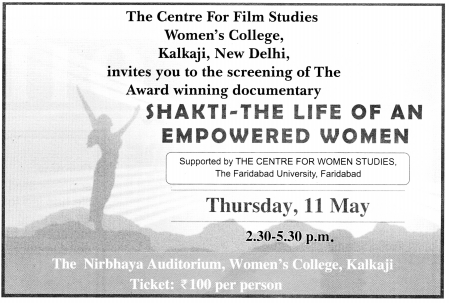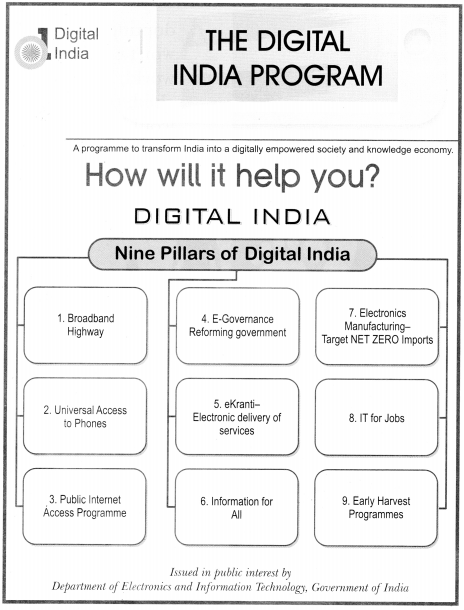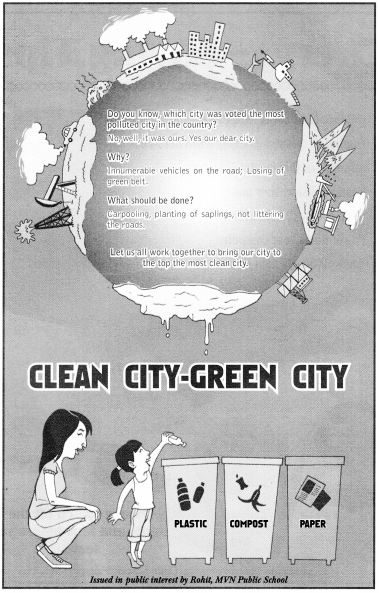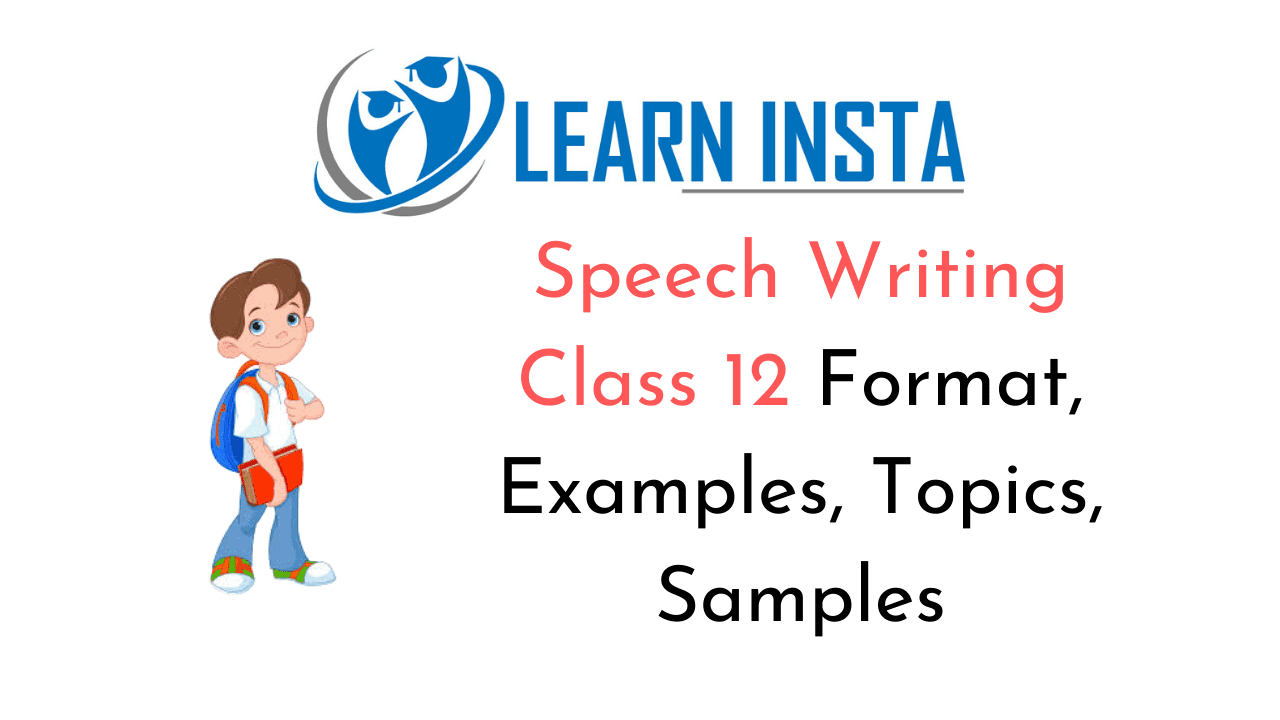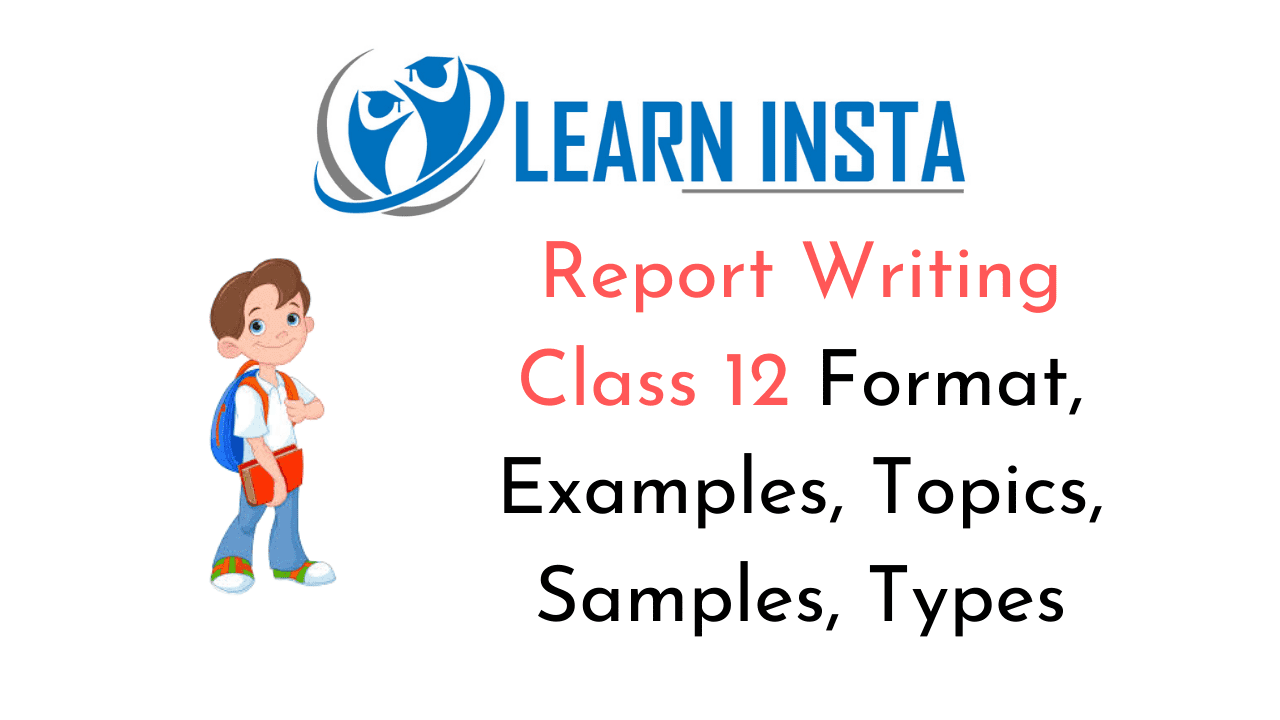
Today, extensive reading is required in each and every field. Be it school, research or work, we are often bombarded with a variety of information. It often becomes difficult to recall all the important ideas we may have read.
This grammar section explains English Grammar in a clear and simple way. There are example sentences to show how the language is used. NCERT Solutions for Class 12 English will help you to write better answers in your Class 12 exams. Because the Solutions are solved by subject matter experts.
Note Making Class 12 Format, Examples
Note-making is a means to capture the key ideas of a given passage in an easily readable, logically-structured format. The main purpose of ‘key to abbreviations’ is to facilitate understanding for the other readers too. Thus, note-making can be a wonderful tool to take notes in class, share notes with each other and even revise for an exam.
♦ Tips to prepare for note-making and summary
- Prepare notes using phrases only and never use complete sentences.
- The topic of each paragraph is the main point/the central theme, and the ideas affiliated to it are the sub-points – one or more depending on the concepts in the paragraph.
- Sub-points should be limited to five.
- Each sub-point may or may not have supplementary ideas which become sub-subpoints. Do not give examples to support the main ideas.
- Proper indentation is essential.
- Provide an appropriate title for the notes and the summary.
- Include a minimum of 4 to 6 distinctly different, recognisable short forms (only necessary) of the longer words (abbreviations) in the notes. You may also use symbols and figures for abbreviation.
- Underline all short forms. Provide the key for the short forms at the end of the notes titled ‘Key to Abbreviations’.
- Cover all the important points in the passage while preparing the notes.
- Identify and club similar ideas scattered in different paragraphs/areas of the passage before subtitling paragraph wise to make notes short and precise.
- Using all the important points in the notes, prepare a cohesive and coherent summary in about 80 words.
- In the summary, use third person indirect speech and the past tense, wherever possible.
- Write the summary in complete sentences in a paragraph. Remember to be short and brief. Give an appropriate title to the summary.
♦ Mechanics of Note-Making:
(a) Use of Abbreviations:
- Capitalized words: UNO, CBSE, NCERT, etc.
- Arithmetic symbols: (><, \, kg, %, etc.)
- Commonly used: (in newspapers, magazines, etc.) (sc., govt., Eng., Sans.)
- Invented: First and last few letters of the words with a dot at the end (edul, poln., popn. mfg.).
(b) Proper Indentation Notes:
1. Sub-Heading
- (Point)
- (Point)
- (Point).
- (i) (Sub-point)
- (ii) (Sub-point)
2. Sub-Heading
(b)
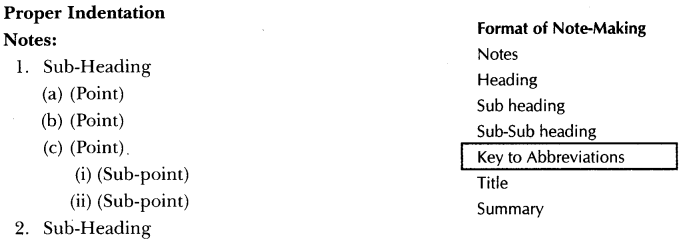
♦ Solved Passages:
Read the following passage carefully. (8 marks)
1. The small village of Somnathpur contains an extraordinary temple, built around 1268 A.D. by the Hoyasalas of Karnataka – one of the most prolific temple-builders. Belur and Halebid are among their better-known works. While these suffered during the invasions of the 14th century, the Somnathpur temple stands more or less intact in near-original condition.
2. This small temple captivates the beauty and vitality of its detailed sculpture, covering almost every inch of the walls, pillars and even ceilings. It has three shikharas and stands on a star-shaped, raised platform with 24 edges. The outer walls have a profusion of detailed carvings: the entire surface run over by carved plaques of stone. There were vertical panels covered by exquisite figures of Gods and Goddesses with many incarnations being depicted.
3. There were nymphs too, some carrying an ear of maize a symbol of plenty and prosperity. The elaborate ornamentation, the very characteristic of Hoyasala sculptures, was a remarkable feature. On closer look and it is worth it – the series of friezes on the outer walls revealed intricately carved caparisoned (covered decorative cloth) elephants, charging horsemen, stylised flowers, warriors, musicians, crocodiles, and swans. The temple was actually commissioned by Soma Dandanayaka or Somnath (he named the village after himself), the minister of the Hoysala king, Narasimha, the third. The temple was built to house three versions of Krishna.
4. The inner centre of the temple was the kalyana mandapa. Leading from here were three corridors each ending in a shrine, one for each kind of Krishna – Venugopala, Janardana and Prasanna Keshava, though only two remain in their original form. In the darkness of the sanctum sanctorum, I tried to discern the different images. The temple’s sculptural perfection is amazing and it includes the doors of the temple and the three elegantly carved towers.
(a) On the basis of your reading of the passage, make notes on it using headings and
sub-headings. Use recognisable abbreviations, wherever necessary. Give the passage a suitable title. (4 marks)
(b) Write a summary of the notes prepared, in not more than 80 words. (4 marks)
Answer:
(a) Notes:
1. Heading – The village temple
1.1 Built in the Village of Somnathpur
1.2 1268 AD – by Hoyasalas
1.3 Most prolific bldrs
1.4 Stands intact even now
2. Temple: the beauty and vitality
2.1 Detailed sculpture – covering walls, pillars, ceilings
2.1.1 series of friezes on outer walls
2.1.2 intricately carved elephants
2.1.3 charging horsemen
2.1.4 stylised flowers
2.1.5 warriors, musicians, crocodile and swans
2.2 Three shikharas – stands shaped, raised platform – 24 edges
2.3 The outer walls – detailed carvings
2.4 The entire surface – carved plaques of stone
2.5 Vertical panels covered by exq. fig.
3. Representation of Hinduism
3.1 Incarnations
3.2 Many deities
4. Temple in the History
4.1 Comsnd. Soma Dandanayaka or Somnath
4.2 The inner centre of the temple – kalyana mandapa
4.3 Three corridors ending in a shrine
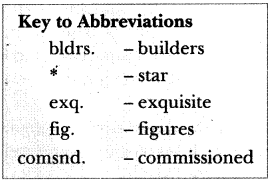
(b) Summary: Temple of Somnathpur
The small village of Somnathpur contains an extraordinary temple, built around 1268 A.D. The temple stands more or less in tact in near original condition even now. The temple of Somnathpur is extraordinary due to the sculptures on the walls, pillars, and even the ceiling which is covered by exquisite figures of Gods and Goddesses. It is a representation of Hinduism with its many incarnations and deities. The temple commissioned by Somnath has a ‘kalyana mandapa’ with three corridors ending in a shrine.
II. Read the following passage carefully. (8 marks)
1. It’s 10 p.m. and the research paper is due the next morning. Sam types frantically. Two weeks ago, it seemed that there was plenty of time to get the paper done. Last week, the final of a soccer match on TV made it hard to study. Now, it’s crunch time. Looking at the clock, Sam wonders, “Why do I keep doing this to myself? Why haven’t I learned not to put things off until the last minute?”
2. The word procrastination comes from the Latin term ‘Procrastinatus’. It means to put forward until tomorrow. Standard dictionary definitions all include the idea of postponement or delay. Steel, a psychologist who has reviewed hundreds of studies on the subject, states that to procrastinate is “to voluntarily delay an intended course of action despite expecting to be worse-off for the delay”.
3. Another expert, Dr Joseph R. Ferrari (2005) distinguishes between people who tend to put things off and “chronic” or “real” procrastinators for whom this is their life and who might even need therapy. Ferrari categorises procrastinators into three types: (a) stimulation types that get a thrill from beating a deadline, (b) avoiders put off doing things that might make others think badly of them, and (c) decisional procrastinators postpone making a decision until they have enough information to avoid making a wrong choice.
4. Chronic procrastinators tend to have a low self-esteem and focus on the past more than the future. The Discounted Expectancy Theory illustrates with a student like Sam who puts off writing a paper. When the deadline is far off, the rewards for socialising now are greater than those for finishing a task not due until later. As the deadline looms, the rewards or consequences for finishing the paper become more important.
5. Tice and Baumeister (1997) found that procrastinators on the average got lower grades and had higher levels of stress and illness. Chu and Choi (2005) however, say that not all procrastinators are lazy and undisciplined. “Passive procrastinators” are more stressed, and less efficient. “Active procrastinators prefer to work under pressure” and “if something unexpectedly comes up, they will knowingly switch gears and engage in new tasks they perceive as more urgent.”
(a) On the basis of your reading of the passage, make notes on it, using headings and sub-headings. Use recognizable abbreviations, wherever necessary. Give the passage a suitable title. (4 marks)
(b) Write a summary of the notes prepared, in not more than 80 words. (4 marks)
Answer:
(a) Notes:
1. Introtn of proctn
1.1 Origin – Latin
1.2 Meaning – Put fwd till tomorrow – Idea of postponement or delay
1.3 Steel (psychologist) – voluntary delay – despite expecting to be worse-off
2. Categortn
2.1 Dr Joseph R. Ferrari
2.1.1 Simtn types – thrill from beating a deadline
2.1.2 Avoiders – avoid things that make others think badly of them
2.1.3 Decisional – postpone making a decsn (until enough information)
2.1.4 Real procs – way of life (might need therapy)
2.1.5 Chronic procs
2.1.5.1 Low self-esteem
2.1.5.2 Focus on past
2.2 Tice and Baumeister
2.2.1 Procs got lower grades
2.2.2 Higher levels of stress and illness
2.3 Chu and Choi
2.3.1 Passive procs – stressed, less efficient
2.3.2 Active procs – prefer to work under pressure, knowingly engage in new tasks (more urgent)
♦ Key to Abbreviations:
- Introtn – Introduction
- Fwd – Forward
- Categortn – Categorisation
- Simtn – Simulation
- Decsn – Decision
- Procs – Procrastinators
- Proctn – Procrastination
(b) Summary: Procrastination
Latin-origin procrastination is the idea of postponement. A psychologist, Steel, says it is a voluntary delay. Dr Joseph R. Ferrari categorises procrastinators into five types: ‘Simulation types feel thrilled’, ‘Avoiders’ fear criticism, ‘Decisions’ wait for information, ‘Reals’ find it natural and might need therapy while ‘Chronic’ ones have low self-esteem and focus on past. Tice and Baumeister say procrastinators get low grades and have high stress and illness. Chu and Choi clarify that passive procrastinators are stressed and less efficient while active procrastinators prioritise.
III. Read the following passage carefully. (8 marks)
1. People tend to amass possessions, sometimes without being aware of doing so. Indeed they can have a delightful surprise when they find something useful which they did not know they owned. Those who never have to change house become indiscriminate collectors of what can only be described as clutter. They leave unwanted objects in drawers, cupboards and attics for years, in the belief that they may one day need just those very things. As they grow old, people also accumulate belongings for two other reasons, lack of physical and mental energy, both of which are essential in turning out and throwing away, and sentiment. Things owned for a long time are full of associations with the past, perhaps with relatives who are dead, and so they gradually acquire a value beyond their true worth.
2. Some things are collected deliberately in the home in an attempt to avoid waste. Among these I would list string and brown paper, kept by thrifty people when a parcel has been opened, to save buying these two requisites. Collecting small items can easily become a mania. I know someone who always cuts out from newspaper sketches of model clothes that she would like to buy, if she had the money. As she is not rich, the chances that she will ever be able to afford such purchases are remote; but she is never sufficiently strong-minded to be able to stop the practice. It is a harmless habit, but it litters up her desk to such an extent that every time she opens it, loose bits of paper fall out in every direction.
3. Collecting as a serious hobby is quite different and has many advantages. It provides relaxation for leisure hours, as just looking at one’s treasures is always a joy. One does not have to go outside for amusement, since the collection is housed at home. Whatever it consists of, stamps, records, first edition of books, china glass, antique furniture, pictures, model cars, stuffed birds, toy animals, there is always something to do in connection with it, from finding the right place for the latest addition to verifying facts in reference books. This hobby educates one not only in the chosen subject but also in general matters which have some bearing on it.
There are also other benefits. One wants to meet like-minded collectors, to get advice, to compare notes, to exchange articles, to show off the latest findings. So one’s circle of friends grows. Soon the hobby leads to travel, perhaps to a meeting in another town, possibly a trip abroad in search of a rare specimen, for collectors are not confined to any one country. Over the years, one may well become an authority on one’s hobby and will very probably be asked to give informal talks to little gatherings and then if successful, to large audiences. In this way, self-confidence grows, first from mastering a subject, then from being able to talk about it. Collecting, by occupying spare time so contented, with no time for boredom.
(a) On the basis of your reading of the passage, make notes on it, using headings and sub-headings. Use recognizable abbreviations, wherever necessary. Give the passage a suitable title. (4 marks)
(b) Write a summary of the notes prepared, in not more than 80 words. (4 marks)
Answer:
(a) Notes:
1. Amassing possessions
1.1 indiscr. collectors
1.2 causes cluster
1.3 unwanted object not disposed
1.4 assoc, with past
1.5 mntl & physical stngth
2. Deliberate collections
2.1 avoid wastage
2.2 collection becomes mania
2.3 harmless habit
3. Collection – hobby
3.1 provides relaxt’n
3.2 edn. & knowledge
3.3 a surge in friend circle
3.4 self-confidence & contentment
♦ Key to Abbreviations:
- indiscr. – indiscriminate
- assoc – association
- mntl – mental
- stngth – strength
- relaxt’n – relaxation
- edn. – education
- & – and
(b) Summary: Collection of Things
Amassing possessions is a mania with many people. We can find indiscriminate collectors who collect unwanted objects. Old people collect things due to lack of strength and it shows their long association. People collect things deliberately to avoid wastage. Though it is a harmless habit, yet collection may be done by weak-minded men also. Collecting can be used as a hobby. It provides relaxation and has educative value. It helps in increasing our circle of friends. It creates self-confidence and contentment.
IV. Read the following passage carefully. (8 marks)
1. It’s a headache having a headache. Almost all of us have suffered from a headache at some time or the other. For some, a headache is a constant companion and life can be a painful hell of wasted time.
2. The most important step to cope with headaches is to identify the type of headache one is suffering from. Intension headache (two-handed headache), feeling of a tight band around the head exists along with pain in the neck and shoulders. It usually follows activities such as long stretches of driving, typing or sitting on the desk. It is usually short-timed, but can also last for days or weeks.
3. A headache is usually caused due to spinal misalignment of the head, due to poor posture. Sleeping on the stomach with the head turned to one side and bending over the position for a long time make it worse.
4. In migraine headache (one-handed headache), the pain is usually on one side of the head and may be accompanied by nausea, vomiting, irritability and bright spots or Hashes of light. This headache is made worse by activity, especially bending. The throbbing pain in the head gets worse by noise and light. Certain triggers for migraines maybe chocolate, smoking, too little sleep or too much of sleep, hunger, etc. The pain may last from 8 to 24 hours and there may be a hangover for two-three days.
5. Migraine is often caused by an “aura”- changes in sight and sensation. There is usually a family history of migraine.
6. In a headache, the pain originates not from the brain but from irritated nerves of muscles, blood vessels and bones. These send pain signals to the brain, which
then judges the degree of distress and relays it to appropriate sites. The pain may sometimes be referred to sites other than the problem areas. This is known as referred pain and occurs due to sensation overload. Thus, though most headaches start at the base of the skull, the referred pain is felt typically behind the eyes.
7. Factors causing headaches are not fully understood but it is known that a shift in the level of body hormones and chemicals, certain food and drinks, and environmental stress can trigger them.
8. If headache troubles you often, visit the doctor who will take a full health history relating to diet, lifestyle, stresses, the type of headache, triggering factors and relief measures. You may be asked to keep a “headache diary” which tells you to list the time the headache started, wThen it ended, emotional, environmental, and food and drink factors which may have contributed to it. The type and severity of pain and the medications used which provided most relief, are also to be listed.
9. This helps the doctor in determining the exact cause and type of headache and the type of drugs to use. Apart from this, a physical examination is done to rule out any serious underlying cause. The blood pressure is recorded, vision tested and muscle coordination of the eyes is checked to rule out these as causes. A blood test may be done to rule out anemia, diabetes and thyroid disease. If any of the above is abnormal or otherwise, a CT Scan or MRI may be done to see tissues and structures around the brain. These will rule out causes such as tumours, hemorrhage, and infection of the brain. This examination gives a clear picture of the problem to the doctor.
10. Immediate relief can be obtained by certain medications and a few simple self-care techniques. Using ice against the pain ‘site’, covering eyes with dark glasses, drinking plenty of fluids and lying down in a dark and quiet room, provide relief in a migraine attack. Painkillers like aspirin, ibuprofen and acetaminophen can be taken and provide relief in different proportions. These should be used with caution and under medical supervision as all of them can cause many side effects if used for long periods and in large quantities. An anti-emetic like perinorm can help nausea associated with a migraine.
(a) On the basis of reading the passage, make notes on it, using headings and sub-headings. Also use recognizable abbreviations, wherever necessary. Give the passage a suitable title to it. (4 marks)
(b) Write a summary of the notes prepared, in not more than 80 words. (4 marks)
Answer:
(a) Notes:
1. Types of H-ache
1.1 tension headache-pain in neck & shoulders
1.2 migraine headache-one-sided irritation in head
2. Symptoms and causes
2.1 driving
2.2 long hours of sitting, typg or desk-work
2.3 genetic or food-oriented
2.4 hormonal imbalance
2.5 uneasy posture while sleep’g
2.6 stress and overburden on head
3. Cure & Tremt.
3.1 self-care of ice-pac
3.2 intake of maxm. fluid
3.3 allopathy painkillers
3.4 doctor’s advice-regular visits
♦ Key to Abbreviations:
- h-ache – headache
- typ’g – typing
- sleep’g – sleeping
- tremt. – treatment
- maxm. – maximum
(b) Summary: Headache-A Common Disorder
Headache is a very common disease in modern age. It is caused due to bodily posture, long hours of sitting and working on the desk, driving continuously and hormonal imbalance in our body. Often stress and uneasy posture of sleeping may cause severe headache. It must be cured with doctor’s advice, by taking painkillers and self-medication, ice-packs on the head, maximum intake of fluid, etc. After a certain age, one should get a regular physical check-up done to identify the kind of headache.
V. Read the following passage carefully. (8 marks)
1. The topic of thought is one area of psychology and many observers have considered this aspect in connection with robots and computers; some of the old worries about artificial intelligence were closely linked to the question of whether computers could think. The first massive electronic computers capable of rapid computation and little or no creative activity were soon dubbed ‘electronic brains’.
A reaction to this terminology quickly followed. To put them in their place, computers were called ‘high-speed idiots’, an effort to protect human vanity. But not everyone realised the implications of high-speed idiot tag. It has not been pointed out often enough that even the human idiot is one of the most intelligent life forms on earth. If the early computers were even that intelligent, it was a remarkable state of affairs.
2. One consequence of speculation about the possibility of computer thought was that we were forced to examine with new care the idea of thought in general. It soon becomes clear that we were not sure what we meant by such terms as ‘thought’ and ‘thinking’. We tend to assume that human beings think, some more than others, though we often call people thoughtless or thinking. Dreams cause a problem, partly because they usually happen outside our control. They are obviously some type of mental experiences, but are they a type of thinking? And the question of non-human life forms adds further problems.
Many of us would maintain that some of higher animals-dogs, cats, apes and so on-are capable of at least basic thought, but what about fish and insects? It is certainly true that the higher mammals show complex brain activity, when tested with the appropriate equipment. And what is true of thought is also true of many other mental processes. One of the immense benefits of artificial intelligence research is that we are being forced to scrutinise with new vigour and the working of human mind.
3. It is already clear that machines have superior mental abilities to many life forms. No fern or oak trees can play chess as well as even the simplest digital computer nor can frogs weld car bodies as well as robots. The three-fingered mechanical manipulator is cleverer in some ways than the three-toed sloth. It seems that, viewed in terms of intellect, the computer should be set well above plants and most animals. Only the higher animals can, it seems, compete with computers with regard to intellect-and even with the diminishing success (Examples of this are in the games of backgammon and chess). Some of the world’s best players are now computers.
(a) On the basis of your reading of the passage, make notes on it, using headings and sub-headings. Also use recognisable abbreviations, wherever necessary. Give the passage a suitable title to it. (4 marks)
(b) Write a summary of the notes prepared, in not more than 80 words. (4 marks)
Answer:
(a) Notes:
1. Psychology
1.1 topic of thought
1.2 conctn to robots & compts
1.3 artificial int.
1.4 can they think?
2. First elec, compts.
2.1 called elecn. brains
2.2 human vanity
2.3 (to put in place) called h.s. idiots
3. The meaning of thought w.r.t.
3.1 lower animals
3.2 higher animals
3.3 machines
4. Machines sup. in int. to many life forms
4.1 fern, or oak trees can’t play chess; compts. can
4.2 frogs can’t weld; robots can
4.3 only higher forms of life can compete for that too, to a limited degree
♦ Key to Abbreviations
- conctn – connection
- & – and
- int. – intelligence
- compts. – computers
- elecn. – electronic
- h.s. – high-speed
- w.r.t. – with respect to
- sup. – superior
(b) Summary: Computers as Thinkers
This topic of thought is an area of psychology. It is concerned with the old worries about artificial intelligence, and the thinking ability of computers. There has been a lot of controversy about whether computers and robots could be called intelligent things or as things having brains. They can work far better than the lower forms of life that are supposed to have some intelligence. Only the higher forms of life can compete with computers and that too, to a limited degree.
♦ Unsolved Passages:
I. Read the following passage carefully. (8 marks)
1. Make In India is a new national program designed to transform India into a global manufacturing hub. It contains a range of proposals designed to urge companies – local and foreign – to invest in India and make the country a manufacturing powerhouse.
2. The focus of Make In India programme is on creating jobs and skill enhancement in 25 sectors. These include automobiles, aviation, chemicals, IT & BPM, pharmaceuticals, construction, defence manufacturing, electrical machinery, food processing, textiles and garments, ports, leather, media and entertainment, wellness, mining, tourism and hospitality, railways, automobile components, renewable energy, mining, biotechnology, space, thermal power, roads and highways, and electronics systems.
3. The Make In India logo is derived from India’s national emblem. The wheel denotes the peaceful progress and dynamism – a sign from India’s enlightened past, pointing the way to a vibrant future. The prowling lion stands for strength, courage, determination and wisdom – values that are every bit as Indian today as they have ever been.
4. Global investors have been quite severe in their criticism about complex rules and bureaucratic red tape that delay investment decisions. India ranks 134 out of 189 countries in the World Bank’s ease of doing business index in 2014. As part of the Make In India initiative, foreign investment caps in construction will be eased to enable greater participation in the NDA government’s 100 smart cities project and affordable housing. The initiative will also target top companies across sectors in identified countries.
Major highlights of the Make In India plans are as follows:
- Invest India cell: An investor facilitation cell set up by the government will act as the first reference point for guiding foreign investors on all aspects of regulatory and policy issues and to assist them in obtaining regulatory clearances.
- Consolidated services and faster security clearances-. All central government services are being integrated with an e-Biz single window online portal, while states have been advised to introduce self-certification.
- Dedicated portal for business queries: A dedicated cell has been created to answer queries from business entities through a newly created web portal (http:// www.makeinindia.com). The back-end support team of the cell would answer specific queries within 72 hours.
- Interactions with the users/visitors: A pro-active approach will be deployed to track visitors for their geographical location, interest and real time user behaviour. Subsequent visits will be customised for the visitor based on the information collected.
- Easing policies and laws: A vast number of defence items have been de-licensed and the validity of industrial license has been extended to three years.
5. With a view to provide flexibility in working hours and increased intake of apprentices for job training, the government plans to introduce a single labour law for small industries by December. An advisory has been sent to all departments/ state governments to simplify and rationalise the regulatory environment (which includes online filing of all returns in a unified form).
6. Narendra Modi stated the reason and motive to launch Make In India very clearly, It is important for the purchasing power of a common man to increase, as this would further boost demand, and hence spur development, in addition to benefiting investors. The faster people are pulled out of poverty and brought into the middle class, the more opportunity will be there for global business. Therefore, investors from abroad need to create jobs. Cost-effective manufacturing and a handsome buyer – one who has purchasing power – are both required. More employment means more purchasing power.
7. Modi had felt a mood of gloom among India’s business community in the last few years, due to lack of clarity on policy issues. He said, “Trust is essential for investors to feel secure. Let us begin with trust; if there is an issue, Government can intervene. Trust, too, can be a transformative force. Development and growth-oriented employment is the government’s responsibility.” To the expression “Look East,” Modi added “Link West”, emphasising on the necessity of a global vision. Referring to his vision of wastewater management and solid waste management in 500 towns across India through public-private partnership, he said that Mission Swachh Bharat and “waste to wealth” could lead to good revenue models for business as well.
(a) On the basis of your reading of the passage, make notes on it, using headings and sub-headings. Use recognisable abbreviations, wherever necessary. Give the passage a suitable title. (4 marks)
(b) Write a summary of the notes prepared, in not more than 80 words. (4 marks)
II. Read the following passage carefully. (8 marks)
1. A scholar is refused admission to a good school primarily because of his weak interactive skills. It is indeed pathetic that though English is spoken fluently and used every day, yet none is satisfied with their abilities. A learner feels that he cannot express himself the way he wants to. And he fails miserably to connect with his own hidden power.
2. The education system, in its endeavours to make Curriculum relevant and life-oriented has, as a matter of fact, fallen short of its standards. It is oblivious of the fact that the most applied and practical subject-English: is devoid of practical afflatus. English is at cross roads. Both aspects of education: the cultural that empowers a learner to grow and the production aspect that makes him do things, is relegated to the background curriculum, thus stands lopsided. It fails to provide full range of services and cannot tap teachers’ expertise. No proper moves and strategies have been formulated to make it unique. English courses are mushrooming and alluring advertisements clip are often spotted.
3. With the onset of the new millennium, demands of the Educational System to sensitise itself to changing societal needs has also increased manifold. The new race of human beings has to be served New Curriculum that caters to the Unity of Thought, Action & Deed, and help evolve an integrated human personality. A Comprehensive Curriculum alone can enhance their understanding of four basic skills.
4. Acquiring the skill of English is no Catwalk. And English is no Science where results are verified; but it means Construction; ingenuity at work. The Architecture that it builds can never be complete, if it is divorced from learning by doing.
5. There are a number of Projects like Phonetics, News reading, Indian literature, poetry-composition, interview skills, biography-launch, etc. which can help a pupil to experiment till he finds a medium that helps free flow of thoughts, to think critically and creatively, and emerge as literary competent. As long as there is proper feeding, English will live in their hearts and reign in their minds. Sooner or later, they will be blessed with a marathon for actionable learning that shall make a multidimensional impact on them. “Within the enclosure (pupils) lies the potential for a new beginning And within this exciting beginning lies an astonishing future for him.”
6. English cannot be conferred so easily and so soon. We need to take control of English. There is a grave need to designate English, without the slightest hesitation, a practical status if at all, we want a remarkable future. The lack of efforts in learning English and the general feeling of not being interested in learning, the English language that are plaguing the system should be urgently addressed. Should not we all battle against this abuse?
(a) On the basis of your reading of the passage, make notes on it, using headings and sub-headings. Use recognisable abbreviations, wherever necessary. Give the passage a suitable title. (4 marks)
(b) Write a summary of the notes prepared, in not more than 80 words. (4 marks)
III. Read the following passage carefully. (8 marks)
1. Chocolate – there’s nothing quite like it, is there? Chocolate is simply delicious. What is chocolate? Where does it come from? Christopher Columbus was probably the first to take cocoa beans from the New World to Europe in around 1502. But the history of chocolate goes back at least 4,000 years! The Aztecs, who lived in America, thought that their bitter cocoa drink was a divine gift from heaven. In fact, scientist Carolus Linnaeus named the plant Theobroma, which means “food of the Gods”.
The Spanish explorer Hernando Cortez went to America in 1519. He visited the Mexican emperor, Montezuma. He saw that Montezuma drank cocoa mixed with vanilla and spices. Cortez took some cocoa home as a gift to the Spanish King Charles. In Spain, people began to drink Cortez’s chocolate in a drink with chili peppers. However, the natural taste of cocoa was too bitter for most people. To sweeten the drink, Europeans added sugar to the cocoa drink. As a sweet drink, it became more popular. By the 17th century, rich people in Europe were drinking it.
2. Later, people started using chocolate in pastries, like pies and cakes. In 1828, Dutch chocolate makers started using a new process for removing the fat from cocoa beans, and getting to the center of the cocoa bean. The Dutch chocolate maker Conrad J. van Houten made a machine that pressed the fat from the bean. The resulting powder mixed better with water than cocoa did. Now, some call Van Houten’s chocolate “Dutch chocolate.”
3. It was easy to mix Dutch chocolate powder with sugar. So other chocolate-makers started trying new recipes that used powdered chocolate. People started mixing sweetened chocolate with cocoa butter to make solid chocolate bars. In 1849, an English chocolate -maker made the first chocolate bar. In the 19th century, the Swiss started making milk chocolate by mixing powdered milk with sweetened chocolate. Milk chocolate has not changed much since this process was invented.
4. Today, two countries – Brazil and Ivory Coast – account for almost half the world’s chocolate. The United States imports most of the chocolates in the world, but the Swiss eats the most chocolate per person. The most chocolate eaten today is sweet milk chocolate, but people also eat white chocolate and dark chocolate.
5. Cocoa and dark chocolate are believed to help prevent heart attacks, or help keep them from happening. They are supposed to be good for the circulatory system. On the other hand, the high fat content of chocolate can cause weight gain, which is not good for people’s health. Other health claims for chocolate have not been proven, but some research shows that chocolate could be good for the brain.
6. Chocolate is a popular holiday gift. A popular Valentine’s Day gift is a box of chocolate candies with a card and flowers. Chocolate is sometimes given for Christmas and birthdays. Chocolate eggs are sometimes given at Easter.
7. Chocolate is toxic to some animals. An ingredient in chocolate is poisonous to dogs, cats, parrots, small rodents, and some livestock. Their bodies cannot process some of the chemicals found in chocolate. Therefore, they should never be fed chocolate.
(a) On the basis of your reading of the passage, make notes on it, using headings and
sub-headings. Use recognisable abbreviations, wherever necessary. Give the passage a suitable title. (4 marks)
(b) Write a summary of the notes prepared, in not more than 80 words. (4 marks)
IV. Read the following passage carefully. (8 marks)
1. The pioneers of the teaching of science imagined that its introduction into education would remove the conventionality, artificiality, and backward-lookingness which were characteristic; of classical studies, but they were gravely disappointed. So, too, in their time had the humanists thought that the study of the classical authors in the original would banish at once the dull pedantry and superstition of mediaeval scholasticism. The professional schoolmaster was a match for both of them, and has almost managed to make the understanding of chemical reactions as dull and as dogmatic an affair as the reading of Virgil’s Aeneid.
2. The chief claim for the use of science in education is that it teaches a child something about the actual universe in which he is living, in making him acquainted with the results of scientific discovery, and at the same time, teaches him how to think logically and inductively by studying scientific method. A certain limited success has been reached in the first of these aims, but practically none at all in the second. Those privileged members of the community, who have been through a secondary or public school education may be expected to know something about the elementary physics and chemistry of a hundred years ago, but they probably know hardly more than any bright boy can pick up from an interest in wireless or scientific hobbies out of school hours.
3. As to the learning of scientific method, the whole thing is palpably a farce. Actually, for the convenience of teachers and the requirements of the examination system, it is necessary that the pupils not only do not learn scientific method but learn precisely the reverse, that is, to believe exactly what they are told and to reproduce it when asked, whether it seems nonsense to them or not. The way in which educated people respond to such quackeries as spiritualism or astrology, not to say more dangerous ones such as racial theories or currency myths, shows that fifty years of education in the method of science in Britain or Germany has produced no visible effect whatever.
The only way of learning the method of science is the long and bitter way of personal experience, and, until the educational or social systems are altered to make this possible, the best we can expect is the production of a minority of people, who are able to acquire some of the techniques of science and a still smaller minority, who are able to use and develop them.
(a) On the basis of your reading of the passage, make notes on it, using headings and
sub-headings. Use recognisable abbreviations, wherever necessary. Give the passage a suitable title. (4 marks)
(b) Write a summary of the notes prepared, in not more than 80 words. (4 marks)
V. Read the following passage carefully. (8 marks)
1. Keeping cities clean is essential for keeping their residents healthy. Our health depends not just on personal hygiene and nutrition, but critically also on how clean we keep our cities and their surroundings. The spread of dengue and chikungunya are intimately linked to the deteriorating state of public health conditions in our cities.
2. The good news is that waste management to keep cities clean is now getting attention through the Swachh Bharat Mission. However, much of the attention begins and stops with the brooms and the dustbins, extending at most to the collection and transportation of the mixed waste to some distant or not so distant place, preferably out of sight.
3. The challenge of processing and treating the different streams of solid waste, and safe disposal of the residuals in scientific landfills, has received much less attention in municipal solid waste management than is expected from a health point of view.
4. One of the problems is that instead of focusing on waste management for health, we have got sidetracked into “waste for energy”. If only we were to begin by not mixing the biodegradable component of solid waste (close to 60 per cent of the total) in our cities with the dry waste, and instead use this stream of waste for composting and producing a gas called methane.
5. City compost from biodegradable waste provides an alternative to farmyard manure (like cow-dung). It provides an opportunity to simultaneously clean up our cities and help improve agricultural productivity and quality of the soil. Organic manure or compost plays a very important role as a supplement to chemical fertilisers in enriching the nutrient-deficient soils. City compost can be the new player in the field.
6. Benefits of compost on the farm are well-known. The water holding capacity of the soil which uses compost helps with drought-proofing, and the requirement of less water per crop is a welcome feature for a water-stressed future. By making the soil porous, use of compost also makes roots stronger and resistant to pests and decay. Farmers using compost, therefore, need less quantity of pesticides. There is also an evidence to suggest that horticulture crops grown with compost have better flavour, size, colour and shelf-life.
7. City compost has the additional advantage of being weed-free unlike farmyard manure which brings with it the seeds of undigested grasses and requires a substantial additional labour cost for weeding as the crops grow. City compost is also rich in organic carbon, and our soils are short in this. Farmers clearly recognise the value of city compost. If city waste was composted before making it available to the farmers for applying to the soil, cities would be cleaned up and the fields around them would be much more productive.
8. Quite apart from cleaning up the cities of biodegradable waste, this would be a major and sustainable contribution to improving the health of our soil without further damage by excessive chemical inputs. What a marvellous change from waste to health!
The good news is that some states are regularly laying plastic roads. Plastic roads will not only withstand future monsoon damage but will also solve a city’s problem of disposing of non-recyclable plastic. It is clear that if the mountains of waste from our cities were to be recycled into road construction material, it would tackle the problem of managing waste while freeing up scarce land. [CBSE Paper 2018]
(a) On the basis of your understanding of the passage make notes on it, using headings
and sub-headings. Use recognizable abbreviations, wherever necessary. Give the passage a suitable title. (4 marks)
(b) Write a summary of the notes prepared, in not more than 80 words. (4 marks)
VI. Read the following passage carefully. (8 marks)
1. To live in harmony with oneself and the environment is the wish of every human. However, in modern times greater physical and emotional demands are constantly placed upon many areas of life. More and more people suffer from physical and mental tension such as stress, anxiety, insomnia, and there is an imbalance in physical activity and proper exercise. That is why, methods and techniques for the attainment and improvement of health, as well as physical, mental and spiritual harmony, are of great importance, and Yoga meets this requirement.
2. The word ‘Yoga’ originates from Sankrit and means ‘to join, to unite’. Yoga exercises have a holistic effect and bring body, mind, consciousness and soul into a balance. In this way, Yoga assists us in coping with everyday demands, problems and worries. Yoga helps to develop a greater understanding of our self, the purpose of life and our relationship with God.
3. On the spiritual path, Yoga leads us to supreme knowledge and eternal bliss in the union of the individual Self with the universal Self. Yoga is that supreme, osmic principle. It is the light of life, the universal creative consciousness that is always awake and never sleeps; that always was, always is, and always will be.
4. Many thousands of years ago in India, Rishis (wise men and saints) explored nature and the cosmos in their meditations. They discovered the laws of the material and spiritual realms and gained an insight into the connections within the universe. They investigated the cosmic laws, the laws of nature and the elements, life on earth, and the powers and energies at work in the universe both in the external world and on a spiritual level. The unity of matter and energy, the origin of the universe and the effects of the elementary powers have been described and explained in the Vedas. Much of this knowledge has been rediscovered and confirmed by modern science.
5. From these experiences and insights a far-reaching and comprehensive system known as Yoga originated and gave us valuable, practical instructions for the body, breathing, concentration, relaxation and meditation. The system ‘Yoga in Daily Life’ is taught worldwide in Yoga Centres, Adult Education Centres, Health Institutions, Fitness and Sports Clubs, Rehabilitation Centres and Health Resorts. It is suitable for all age groups – the name itself indicates that Yoga can be and should be used ‘in Daily Life’.
6. The exercise levels have been worked out in consultation with doctors and physiotherapists and can therefore – with the observation of the stated rules and precautions- be practised independently at home by anyone. ‘Yoga in Daily Life’ is a holistic system, which means it takes into consideration not only the physical but also the mental and spiritual aspects. Positive thinking, perseverance, discipline, orientation towards the Supreme, prayer as well as kindness and understanding, form the way of‘self-knowledge’ and ‘self-realisation’. [CBSE 2019]
(a) On the basis of your understanding of the passage, make notes on it, using headlines and sub-headings. Also use recognisable abbreviations, wherever necessary. Give the passage a suitable title to it. (4 marks)
(b) Write a summary of the notes prepared, in not more than 80 words. (4 marks)
